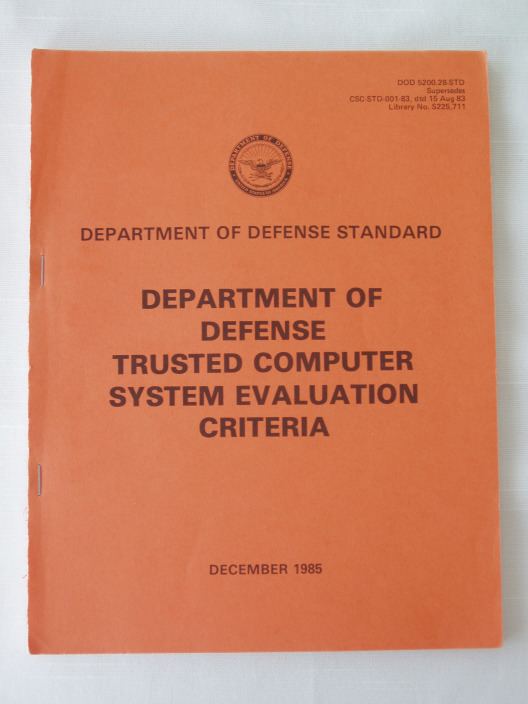Trusted Computer System Evaluation Criteria (TCSEC) is a United States Government Department of Defense (DoD) standard that sets basic requirements for assessing the effectiveness of computer security controls built into a computer system. The TCSEC was used to evaluate, classify and select computer systems being considered for the processing, storage and retrieval of sensitive or classified information.
The TCSEC, frequently referred to as the Orange Book, is the centerpiece of the DoD Rainbow Series publications. Initially issued in 1983 by the National Computer Security Center (NCSC), an arm of the National Security Agency, and then updated in 1985. TCSEC was replaced by the Common Criteria international standard originally published in 2005.
Fundamental objectives and requirements
The Orange Book or DoDD 5200.28-STD was canceled by DoDD 8500.1 on October 24, 2002. DoDD 8500.1 reissued as DoDI 8500.02 on March 14, 2014.
The security policy must be explicit, well-defined and enforced by the computer system. There are three basic security policies:
Mandatory Security Policy - Enforces access control rules based directly on an individual's clearance, authorization for the information and the confidentiality level of the information being sought. Other indirect factors are physical and environmental. This policy must also accurately reflect the laws, general policies and other relevant guidance from which the rules are derived.Marking - Systems designed to enforce a mandatory security policy must store and preserve the integrity of access control labels and retain the labels if the object is exported.Discretionary Security Policy - Enforces a consistent set of rules for controlling and limiting access based on identified individuals who have been determined to have a need-to-know for the information.Individual accountability regardless of policy must be enforced. A secure means must exist to ensure the access of an authorized and competent agent which can then evaluate the accountability information within a reasonable amount of time and without undue difficulty. There are three requirements under the accountability objective:
Identification - The process used to recognize an individual user.Authentication - The verification of an individual user's authorization to specific categories of information.Auditing - Audit information must be selectively kept and protected so that actions affecting security can be traced to the authenticated individual.The computer system must contain hardware/software mechanisms that can be independently evaluated to provide sufficient assurance that the system enforces the above requirements. By extension, assurance must include a guarantee that the trusted portion of the system works only as intended. To accomplish these objectives, two types of assurance are needed with their respective elements:
Assurance MechanismsOperational Assurance: System Architecture, System Integrity, Covert Channel Analysis, Trusted Facility Management and Trusted RecoveryLife-cycle Assurance : Security Testing, Design Specification and Verification, Configuration Management and Trusted System DistributionContinuous Protection Assurance - The trusted mechanisms that enforce these basic requirements must be continuously protected against tampering and/or unauthorized changes.Within each class there is additional documentation set which addresses the development, deployment and management of the system rather than its capabilities. This documentation includes:
Security Features User's Guide, Trusted Facility Manual, Test Documentation and Design DocumentationDivisions and classes
The TCSEC defines four divisions: D, C, B and A where division A has the highest security. Each division represents a significant difference in the trust an individual or organization can place on the evaluated system. Additionally divisions C, B and A are broken into a series of hierarchical subdivisions called classes: C1, C2, B1, B2, B3 and A1.
Each division and class expands or modifies as indicated the requirements of the immediately prior division or class.
Reserved for those systems that have been evaluated but that fail to meet the requirements for a higher divisionC1 — Discretionary Security ProtectionIdentification and authenticationSeparation of users and dataDiscretionary Access Control (DAC) capable of enforcing access limitations on an individual basisRequired System Documentation and user manualsC2 — Controlled Access ProtectionMore finely grained DACIndividual accountability through login proceduresAudit trailsObject reuseResource isolationB — Mandatory protection
B1 — Labeled Security ProtectionInformal statement of the security policy modelData sensitivity labelsMandatory Access Control (MAC) over selected subjects and objectsLabel exportation capabilitiesSome discovered flaws must be removed or otherwise mitigated (Not Sure)Design specifications and verificationB2 — Structured ProtectionSecurity policy model clearly defined and formally documentedDAC and MAC enforcement extended to all subjects and objectsCovert storage channels are analyzed for occurrence and bandwidthCarefully structured into protection-critical and non-protection-critical elementsDesign and implementation enable more comprehensive testing and reviewAuthentication mechanisms are strengthenedTrusted facility management is provided with administrator and operator segregationStrict configuration management controls are imposedOperator and Administrator roles are separated.B3 — Security DomainsSatisfies reference monitor requirementsStructured to exclude code not essential to security policy enforcementSignificant system engineering directed toward minimizing complexitySecurity administrator role definedAudit security-relevant eventsAutomated imminent intrusion detection, notification, and responseTrusted system recovery proceduresCovert timing channels are analyzed for occurrence and bandwidthAn example of such a system is the XTS-300, a precursor to the XTS-400A1 — Verified DesignFunctionally identical to B3Formal design and verification techniques including a formal top-level specificationFormal management and distribution proceduresExamples of A1-class systems are Honeywell's SCOMP, Aesec's GEMSOS, and Boeing's SNS Server. Two that were unevaluated were the production LOCK platform and the cancelled DEC VAX Security Kernel.Beyond A1System Architecture demonstrates that the requirements of self-protection and completeness for reference monitors have been implemented in the Trusted Computing Base (TCB).Security Testing automatically generates test-case from the formal top-level specification or formal lower-level specifications.Formal Specification and Verification is where the TCB is verified down to the source code level, using formal verification methods where feasible.Trusted Design Environment is where the TCB is designed in a trusted facility with only trusted (cleared) personnel.Army Regulation 380-19 is an example of a guide to determining which system class should be used in a given situation.

